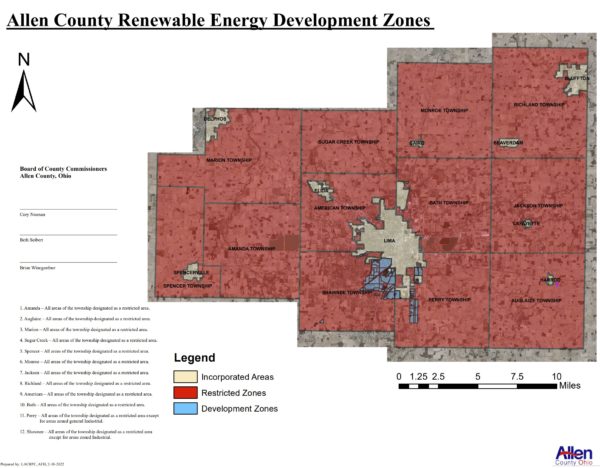Ten Ohio counties have banned large-scale wind and solar farms, and two more are currently considering a ban. This was enabled by Ohio putting into law SB 52 in the fall of 2021.
This news was brought to the attention of pv magazine USA by local reporters at the Ohio Capital Journal. The list of counties that have officially banned wind and/or solar energy is as follows:
- Seneca County, Nov. 23
- Medina County, Jan. 25
- Logan County, April 14
- Hancock County, April 19
- Allen County, April 24
- Auglaize County, April 26
- Union County, June 15 large solar projects (not wind)
- Butler County, June 23
- Crawford County may ban wind farms, though reports show that a potential wind farm developer has submitted enough signatures to place the issue on the ballot in November
- Knox County, Aug. 11 banning large wind projects (not solar)
The Journal notes that Ottawa & Delaware Counties are discussing the topic as well.
Allen County’s ban affects essentially the entire county minus some downtown areas, according to the map provided on the county website.

The specific language in SB 52 that gives control over the local jurisdiction is:
Sec. 303.58. (A) The board of county commissioners may adopt a resolution designating all or part of the unincorporated area of a county as a restricted area prohibiting the construction of any or all of the following:
(1) An economically significant wind farm;
(2) A large wind farm;
(3) A large solar facility.
A “large solar facility,” per the definitions of SB 52, is defined in section 4906.01 of the Revised Code: (G) “Large solar facility” means an electric generating plant that consists of solar panels and associated facilities with a single interconnection to the electrical grid that is a major utility facility.
None of the state level documents reference specific size limits for solar farms. Allen County’s ban notes that landowners “have the right and ability to contract with wind and solar companies for operations under 50MW.” The county’s meeting minutes note that while many residents support wind and solar, they reject large industrial facilities.
Logan County also says that above 50 MW is banned, while also placing restrictions on projects 5 to 50 MW.
Notably, many Ohio politicians – all the way up to the Governor’s office – are embroiled in a bribery scandal implemented by coal facility owners. Tens of millions of dollars were paid to various politicians and intermediaries to implement laws that gave billions in incentives to coal and nuclear facilities.
In terms of popularity, rooftop solar is highly supported by mostly everyone. Support falls off sharply for any solar on the ground, however, some ground solar was better received than others.

Research in New York State suggests that support shifts as solar power facilities approach approximately 50 acres. Larger facilities that sell all of their electricity into the transmission market are given less support, whereas facilities defined as ‘community solar,’ and do not cross over multiple parcels, have higher levels of support.
The State of Ohio is currently developing laws for community solar, though none have yet been implemented as law.
This content is protected by copyright and may not be reused. If you want to cooperate with us and would like to reuse some of our content, please contact: editors@pv-magazine.com.








Surprise! Surprise! Surprise! NOT! . . .
“Notably, many Ohio politicians – all the way up to the Governor’s office – are embroiled in a bribery scandal implemented by coal facility owners. Tens of millions of dollars were paid to various politicians and intermediaries to implement laws that gave billions in incentives to coal and nuclear facilities.”
This does not stop small scale, small farm solar or wind operations and the “inflation reduction act” will give farmers money to build the small farm systems. This is a win for small farmers who want more money back, for the solar they install, from the utility. The utility cannot point out the cheap prices they pay from the 2 cent per kilo watt hour large industrial farms like the California utilities do to quash the value of solar power from homeowners or small producers with solar. Now the farmers and residents need to put solar on their roofs and start saving money.
It’s a shame. Beautiful state like that not using natures resources to not only help the environment, but bring jobs. Just think of the 56 closed landfills that could be used.
It would seem that agrivoltaics would be a win-win for everyone, even for large scale solar. Ok, maybe not a win for the coal digging and burning industries.
You mention beautiful Ohio. Some people are just trying to ban huge solar ground arrays and wind farms that are ugly large scale money makers for utility companies and utility companies scarring our rural areas.
Hi. :} Among the Leaders, Ohio, again…
Out here, in Nevada, especially after down to the last minute 2020’s state ballot measures, internationally financiered energy development corporations can legally get permits for “regional” scale destruction of remaining Mojave Desert “biological refugia” wildlands, and their singular inhabitants. Other extractive industry corporations are here, for the same free passes on DOD, DOE, DOI lands. If you ever wanted to be out in “the mineral silence” hereabouts, or spend a few nights camped, do it sooner than later.
If we can’t get leaders here, we’d be happy to get effective “Delayers”, so PV tech and engineering can just keep launching past the “large array infrastructure on free land” ideals of 1976 FLPMA-culture business models .
No part of the Mojave Desert was or is “free, “unlimited” “wasteland”.